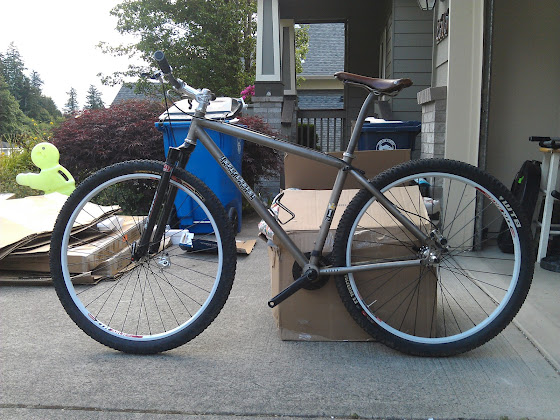Thanks to Jude at Sugar Wheel Works, my old Independent Fabrications single-speed is slowly turning into a bike again. When NoTubes sent me some rims to help bring an old Industry Nine wheelset back from the dead, I was really looking forward to asking Jude to do the build. There’s just a great vibe to Sugar Wheel Works, which shares an enormous building with a bunch of other really interesting businesses. In addition to building wheels, Sugar Wheel Works also offers wheelbuilding classes. It’s a simple kind of business model–offer a service, plus classes on how to do it yourself–that seems to be growing. Only today I found out Carl Schlemowitz from Vicious Cycles is starting something similar with frame building and painting.
So the Indy Fab is on the way back to life. Now it’s down to sorting through boxes and trying to find the rest of the parts I need to finish piecing it together.
This weekend I also finished a pivot redesign on Project Danzig that relocated all the pivot points to allow for even more freedom of motion around the bottom bracket shell. The goal was to ensure ample room for PressFit 30 and similar bottom bracket diameters. In the process, I had to rebuild my main frame around the fresh pivot locations and recreate my axle path from the ground up (literally). Here’s an approximation of what it looks like right now.
We’ve looked at instant centers, axle paths and chains a bit, but one of the specific elements I’ve prioritized throughout all the iterations of this design has do with the relationship of the axle path to the chain. The drawing above illustrates my goal for the axle path.
How you arrange your pivots dictates not only how far rearward your axle can travel relative to its starting point, but at what point in the compression the axle is furthest away from the bike’s bottom bracket. As the axle travels upward, it has the opportunity to move rearward slightly. What I want with this design is for the point at which the axle is furthest away from the bottom bracket to be just past the sag point on the bike.
Why is that? Because chains aren’t elastic. Tension through the line of the chain will keep trying to pull the rear axle toward the bottom bracket shell. By designing a suspension system that needs to move rearward in order to keep compressing right at the point at which pedaling tries to pull the rear axle forward to counteract that rearward movement, the obvious goal is to cancel out pedaling forces. We’re talking halves of millimeters in some cases, but the objective is to turn the chain force into a positive when it comes to eliminating pedal bob.
Factor in the much larger wheels of a 29er or 650b bike, and it can become more challenging to align those two. It was a need to create a longer travel 29er that still had short chainstays that led me to design a frame in the first place. Going forward, I’ll try to explain a little more about the challenges of a bike with larger wheels, how axle path gets involved in all this, and how that led me to design this system.


